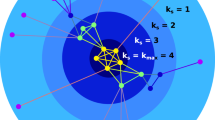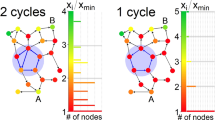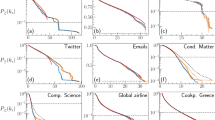Abstract
Collapses of dynamical systems into irrecoverable states are observed in ecosystems, human societies, financial systems and network infrastructures. Despite their widespread occurrence and impact, these events remain largely unpredictable. In searching for the causes for collapse and instability, theoretical investigations have so far been unable to determine quantitatively the influence of the structural features of the network formed by the interacting species. Here, we derive the condition for the stability of a mutualistic ecosystem as a constraint on the strength of the dynamical interactions between species and a topological invariant of the network: the k-core. Our solution predicts that when species located at the maximum k-core of the network go extinct, as a consequence of sufficiently weak interaction strengths, the system will reach the tipping point of its collapse. As a key variable involved in collapse phenomena, monitoring the k-core of the network may prove a powerful method to anticipate catastrophic events in the vast context that stretches from ecological and biological networks to finance.
This is a preview of subscription content, access via your institution
Access options
Access Nature and 54 other Nature Portfolio journals
Get Nature+, our best-value online-access subscription
$29.99 / 30 days
cancel any time
Subscribe to this journal
Receive 12 print issues and online access
$209.00 per year
only $17.42 per issue
Buy this article
- Purchase on Springer Link
- Instant access to full article PDF
Prices may be subject to local taxes which are calculated during checkout





Similar content being viewed by others
Data availability
Data that support the findings of this study are publicly available at the Interaction Web Database at https://www.nceas.ucsb.edu/interactionweb/.
References
May, R. M. Will a large complex system be stable? Nature 238, 413–414 (1972).
Strogatz, S. Nonlinear Dynamics and Chaos: With Applications to Physics, Biology, Chemistry, and Engineering (Westview Press, 2000).
Caldarelli, G. & Vespignani, A. Large Scale Structure and Dynamics of Complex Networks: From Information Technology to Finance and Natural Science (World Scientific, Singapore, 2007).
Buldyrev, S. V., Parshani, R., Paul, G., Stanley, H. E. & Havlin, S. Catastrophic cascade of failures in interdependent networks. Nature 464, 1025–1028 (2010).
Scheffer, M. et al. Early-warning signals for critical transitions. Nature 461, 53–59 (2009).
Scheffer, M. et al. Anticipating critical transitions. Science 338, 344–348 (2012).
Allesina, S. & Tang, S. Stability criteria for complex ecosystems. Nature 483, 205–208 (2012).
Gao, J., Barzel, B. & Barabási, A.-L. Universal resilience patterns in complex networks. Nature 530, 307–312 (2016).
Bascompte, J., Jordano, P. & Olesen, J. M. Asymmetric coevolutionary networks facilitate biodiversity maintenance. Science 312, 431–433 (2006).
Coyte, K. Z., Schluter, J. & Foster, K. R. The ecology of the microbiome: networks, competition, and stability. Science 350, 663–666 (2015).
Haldane, A. G. & May, R. M. Systemic risk in banking ecosystems. Nature 469, 351–355 (2011).
Battiston, S., Caldarelli, G., Georg, C.-P., May, R. M. & Stiglitz, J. Complex derivatives. Nat. Phys. 9, 123–125 (2013).
Dai, L., Vorselen, D., Korolev, K. S. & Gore, J. Generic indicators for loss of resilience before a tipping point leading to population collapse. Science 336, 1175–1177 (2012).
Seidman, S. B. Network structure and minimum degree. Soc. Networks 5, 269–287 (1983).
Pittel, B., Spencer, J. & Wormald, N. Sudden emergence of a giant k-core in a random graph. J. Comb. Theory B 67, 111–151 (1996).
Dorogovtsev, S. N., Goltsev, A. V. & Mendes, J. F. F. k-core organization of complex networks. Phys. Rev. Lett. 96, 040601 (2006).
Carmi, S., Havlin, S., Kirkpatrick, S., Shavitt, Y. & Shir, E. A model of Internet topology using k-shell decomposition. Proc. Natl Acad. Sci. USA 104, 11150–11154 (2007).
Alvarez-Hamelin, J. I., Dall’Asta, L., Barrat, A. & Vespignani, A. k-core decomposition of the Internet graphs: hierarchies, self-similarity and measurement biases. Netw. Heterog. Media 3, 371 (2008).
Kitsak, M. et al. Identification of influential spreaders in complex networks. Nat. Phys. 6, 888–893 (2010).
Hagmann, P. et al. Mapping the structural core of human cerebral cortex. PLoS Biol. 6, e159 (2008).
Morone, F., Burleson-Lesser, K., Vinutha, H. A., Sastry, S. & Makse, H. A. The jamming transition is a k-core percolation transition. Preprint at https://arXiv.org/abs/1804.07804 (2018).
May, R. M. Mutualistic interactions among species. Nature 296, 803–804 (1982).
Holland, J. N., DeAngelis, D. L. & Bronstein, J. L. Population dynamics and mutualism: functional responses of benefits and costs. Am. Nat. 159, 231–244 (2002).
Bastolla, U. et al. The architecture of mutualistic networks minimizes competition and increases biodiversity. Nature 458, 1018–1020 (2009).
Thebault, E. & Fontaine, C. Stability of ecological communities and the architecture of mutualistic and trophic networks. Science 329, 853–856 (2010).
Alon, U. An Introduction to Systems Biology: Design Principles of Biological Circuits (CRC Press, Boca Raton, 2006).
Amit, D. J. Modeling Brain Function: The World of Attractor Neural Networks (Cambridge Univ. Press, Cambridge, 1989).
Sompolinsky, H., Crisanti, A. & Sommers, H. J. Chaos in random neural networks. Phys. Rev. Lett. 61, 259–262 (1988).
Okuyama, T. & Holland, J. N. Network structural properties mediate the stability of mutualistic communities. Ecol. Lett. 11, 208–216 (2008).
Arroyo, M. T. K., Primack, R. B. & Armesto, J. J. Community studies in pollination ecology in the high temperate Andes of Central Chile. I. Pollination mechanisms and altitudinal variation. Amer. J. Bot. 69, 82–97 (1982).
May, R. M. Simple mathematical models with very complicated dynamics. Nature 261, 459–467 (1976).
Shen-Orr, S. S., Milo, R., Mangan, S. & Alon, U. Network motifs in the transcriptional regulation network of Escherichia coli. Nat. Genet. 31, 64–68 (2002).
Kauffman, S. A. The Origins of Order: Self-organization and Selection in Evolution (Oxford Univ. Press, New York, 1993).
Glass, L. & Kauffman, S. A. The logical analysis of continuous, non-linear biochemical control networks. J. Theor. Biol. 38, 103–129 (1973).
Rohr, R. P., Saavedra, S. & Bascompte, J. On the structural stability of mutualistic systems. Science 345, 1253497 (2014).
Bascompte, J., Jordano, P., Melián, C. J. & Olesen, J. M. The nested assembly of plant-animal mutualistic networks. Proc. Natl Acad. Sci. USA 100, 9383–9387 (2003).
Staniczenko, P. P. A., Kopp, J. C. & Allesina, S. The ghost of nestedness in ecological networks. Nat. Commun. 4, 1931 (2013).
Bickle, A. Cores and shells of graphs. Math. Bohem. 138, 43–59 (2013).
Berry, D. & Widder, S. Deciphering microbial interactions and detecting keystone species with co-occurrence networks. Front. Microbiol. 5, 00219 (2014).
Morone, F. & Makse, H. A. Influence maximization in complex networks through optimal percolation. Nature 524, 65–68 (2015).
Bucci, V., Bradde, S., Biroli, G. & Xavier, J. B. Social interaction, noise and antibiotic-mediated switches in the intestinal microbiota. PLoS. Comput. Biol. 8, e1002497 (2012).
Kato, M., Makutani, T., Inoue, T. & Itino, T. Insect–flower relationship in the primary beech forest of Ashu, Kyoto: an overview of the flowering phenology and seasonal pattern of insect visits. Contr. Biol. Lab. Kyoto Univ. 27, 309–375 (1990).
Acknowledgements
Research was sponsored by NSF-IIS 1515022, NIH-NIBIB R01EB022720, NIH-NCI U54CA137788/U54CA132378 and Army Research Laboratory under Cooperative Agreement W911NF-09-2-0053 (ARL Network Science CTA). We are grateful to S. Alarcón for discussions.
Author information
Authors and Affiliations
Contributions
All authors contributed equally to all parts of the study.
Corresponding author
Ethics declarations
Competing interests
The authors declare no competing interests.
Additional information
Publisher’s note: Springer Nature remains neutral with regard to jurisdictional claims in published maps and institutional affiliations.
Supplementary information
Supplementary Information
Supplementary Figures, Tables, Notes and References
Rights and permissions
About this article
Cite this article
Morone, F., Del Ferraro, G. & Makse, H.A. The k-core as a predictor of structural collapse in mutualistic ecosystems. Nature Phys 15, 95–102 (2019). https://doi.org/10.1038/s41567-018-0304-8
Received:
Accepted:
Published:
Issue Date:
DOI: https://doi.org/10.1038/s41567-018-0304-8
This article is cited by
-
Ranking species in complex ecosystems through nestedness maximization
Communications Physics (2024)
-
Teleconnections among tipping elements in the Earth system
Nature Climate Change (2023)
-
Fractional core-based collapse mechanism and structural optimization in complex systems
Science China Information Sciences (2023)
-
Cycle-tree guided attack of random K-core: Spin glass model and efficient message-passing algorithm
Science China Physics, Mechanics & Astronomy (2022)
-
Anchored coreness: efficient reinforcement of social networks
The VLDB Journal (2022)



